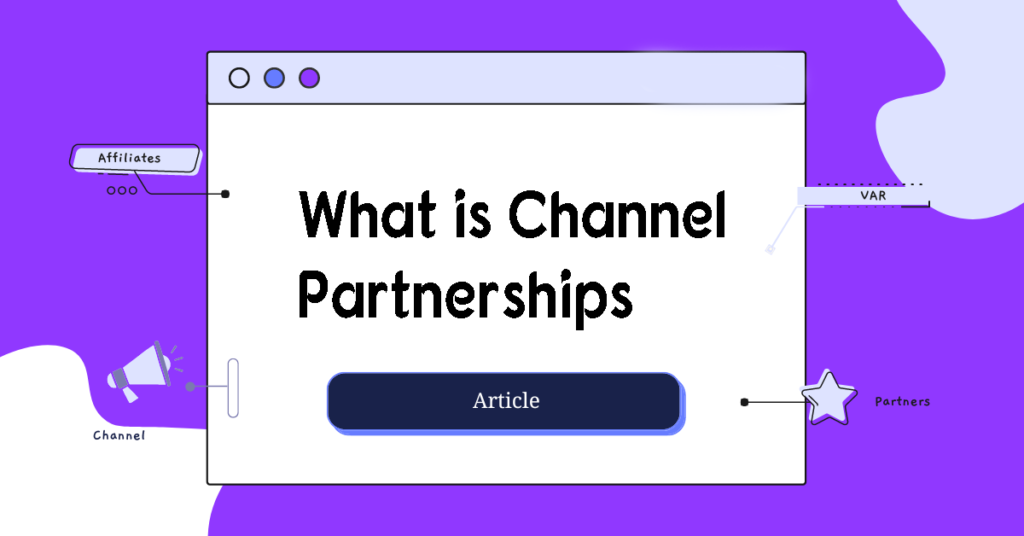Entering the world of partner marketing can seem like an intimidating endeavor, especially if you’re new to this strategy. However, with a little insight and understanding, it’s a powerful tool that can significantly propel your business growth.
Browsing through countless articles and forums might lead you to believe that partner marketing is complex or reserved only for large corporations. This simply isn’t true.
“54% of companies report brand partnerships drive over 20% of their total annual revenue.”
This statistic alone underscores the immense potential held by effective partner marketing strategies. It’s not just about teaming up with another company; it’s about leveraging each other’s strengths to achieve mutual goals more efficiently than going at it alone.
The ever-evolving landscape of digital marketing has made way for innovative collaboration methods such as these – disrupting traditional approaches
Maximizing Growth with Strategic Partner Marketing
Unleash the potential of partner marketing. Discover strategies, types of partnerships, and success stories to fuel your business growth.
Unraveling the Power of Partner Marketing
The realm of partner marketing is vast, and teeming with potential. This strategic collaboration brings together businesses or individuals to capitalize on their unique strengths and achieve mutual goals.
A world where synergy amplifies capabilities and reach.
To illustrate its power, consider this: 54% of companies report that brand partnerships contribute over 20% to their total revenue. Such figures highlight not only the importance but also the profitability inherent in these strategies for both established corporations and smaller brands alike.
Mechanics Behind Effective Partner Marketing
In essence, it’s about leveraging shared audiences, resources, and objectives for maximum impact. By tapping into another brand’s customer base through partnership marketing efforts like affiliate partners or influencer collaborations, you can extend your market segments without significant investment in customer acquisition initiatives. This means more eyeballs on your products at a lower cost.
Sharing resources such as content creators or product placements further reduces costs while still achieving high-quality results – all thanks to effective strategic collaboration within relevant industries. The result? A win-win scenario benefiting everyone involved – from partnering brands right down to consumers who enjoy enriched offerings due to joint ventures between complementary entities.
Navigating Partnership Successes
To kick off successful partnership marketing, it takes careful planning around two key components: alignment on mutual benefits (think increased sales performance) and clear communication throughout execution stages. Both parties need an understanding of what they stand to gain from the alliance, whether it be expanded reach, improved lead generation resulting from combined campaigns, etc. Frequent check-ins ensure everybody remains on track towards a common goal and allows adjustments needed based on real-time feedback received during campaign progress reports.
Potential Outcomes Unleashed by Successful Collaboration
When executed effectively, partner marketing significantly increases brand awareness among target demographics previously untapped by an individual entity alone. Moreover, because they often involve co-creation processes (
Key Takeaway:
Strategic partner marketing is a goldmine for business growth. It’s about pooling strengths, sharing audiences and resources to amplify reach and profitability. The key? Alignment on mutual benefits, clear communication, and frequent check-ins for smooth execution.
The Distinction Between Marketing Partnerships and Business Partnerships
When forming alliances for your enterprise, it is essential to be aware of the disparity between marketing partnerships and business partnerships. Each type of partnership serves a distinct purpose, carries unique legal implications, and has different tax considerations.
How Legal Aspects Impact Both Types of Partnerships
In the realm of business partnerships, partners share ownership responsibilities. This means they are collectively responsible for any debts or liabilities incurred by their venture. The structure can vary from general arrangements where all parties have equal liability to limited ones that offer individual protection against certain risks.
A contrastingly lighter form of collaboration is seen in marketing partnerships; these involve businesses joining forces on specific projects or campaigns with mutual benefit as the end goal. Herein lies no implication of shared ownership or financial responsibility beyond what’s outlined in an agreement.
Tax Implications for Marketing vs. Business Partnerships
Fiscal matters also draw a clear line between these two types of collaborations. In traditional business ventures, profits get taxed as personal income based on each partner’s proportionate earnings – this follows principles common with sole proprietorships and LLCs which operate under pass-through taxation rules.
Marketing alliances take a more independent approach when it comes to taxes – there isn’t direct profit sharing at an organizational level so each entity remains independently taxable according to its own revenue generation activities outside joint initiatives undertaken within such strategic collaborations.
Unravel the intricacies of business and marketing partnerships. Understand their unique legal implications, tax considerations, and how they can fuel your growth. #BusinessGrowth #PartnershipMarketingClick to Tweet
Harnessing Benefits Through Strategic Collaboration
Strategic collaboration in partner marketing is a game-changer. It’s not just about financial gains; it’s about leveraging each other’s strengths and reaching similar audience segments effectively.
The power of increased brand awareness cannot be overstated.
Your brand can gain exposure to an entirely new customer base by joining forces with another business, thereby expanding your reach significantly. This wider audience doesn’t only boost visibility but also enhances the potential for sales growth. Forbes provides further insights on how these synergies work in practice (source removed).
Selecting Suitable Partners
Finding the right collaborator isn’t a straightforward process; it necessitates mindful contemplation and coordination over numerous components, such as aims, intended audiences, and long-term plans.
A successful partnership involves more than just shared goals; it demands harmony at every level, from values to offerings or market segments (source removed).
Setting Measurable Goals
These benchmarks provide clear direction while allowing both parties to track progress accurately throughout their collaborative journey.
In addition to setting targets around revenue generation or customer acquisition numbers, consider focusing on improving lead generation efforts or enhancing customer satisfaction levels.
By harnessing these benefits through strategic collaborations within partner marketing campaigns, companies don’t merely survive – they thrive. They achieve substantial mutual benefit while extending their reach beyond traditional boundaries.
Unleash the power of strategic collaboration in partner marketing. It’s not just about financial gains, it’s about leveraging strengths and expanding your reach. #PartnerMarketing #BusinessGrowthClick to Tweet
Navigating Potential Drawbacks in Partner Marketing
As with any marketing strategy, partner marketing is not without its potential pitfalls. One of the most common challenges lies in aligning goals and expectations between partners.
Misalignment can lead to underperformance or even failure.
A quote by Thomas Edison comes to mind: “Vision without execution is hallucination.”
In partner marketing, both parties need a shared vision that’s executed effectively for mutual benefit. However, when one party falls short or has different objectives, it can hinder overall success.
The Crucial Role Of Clear Partnership Agreements
To mitigate these risks and ensure smooth sailing throughout your partnership collaboration journey, creating comprehensive agreements from the get-go becomes essential.
This document should detail each party’s roles and responsibilities clearly so there are no surprises down the line. It acts as an operational roadmap that minimizes misunderstandings while providing legal protection regarding profit sharing arrangements, intellectual property rights, among other aspects related to strategic partners’ operations.
Paving The Way With Careful Planning And Communication
Careful planning also plays a significant role in mitigating potential drawbacks associated with partner marketing strategies.
An effective plan involves thorough research about prospective partners before entering into any agreement. Ensuring their customer base demographics match yours will help tailor joint campaigns to reach relevant audiences more effectively, increasing chances of successful outcomes.
Besides careful planning, maintaining open and transparent communication is pivotal in sustaining long-term relationships built on trust and respect. This helps achieve common goals together and successfully navigate possible obstacles that arise during the course of a campaign. Issues and disagreements arising due to a lack of clarity on certain matters can be resolved upfront through clear dialogue and understanding.
Avoid the pitfalls of partner marketing. Align goals, create clear agreements and maintain open communication for mutual success. Remember: “Vision without execution is hallucination.” #PartnerMarketing #BusinessGrowthClick to Tweet
Exploring Successful Examples of Partnership Marketing
The landscape of partnership marketing is teeming with success stories that have significantly elevated businesses. When executed well, these collaborations can result in significant benefits such as increased sales and enhanced brand visibility.
Constant Contact’s Success Story
A standout example comes from Constant Contact, a leading provider of email marketing services. The company employed partner marketing by aligning with various independent companies to offer effective solutions for customer problems.
This strategic collaboration not only allowed Constant Contact to expand its customer base but also provided additional value to existing customers. Consequently, the company experienced an uptick in both customer retention and acquisition rates.
American Forests’ Green Initiative with TAZO Teas
In another case study, American Forests partnered up with TAZO teas for a worthy cause – combating climate change through tree planting efforts. This was more than just your average partnership; it was built on shared values and mutual benefit.
The campaign smartly engaged content creators who resonated well within their brands’ audiences across social media platforms like Instagram and YouTube. By leveraging these influencers as trusted voices within their respective communities, they were able to reach wider audience segments while increasing brand awareness around their initiative.
Leveraging Different Types Of Marketing Partnerships
Different types of partnerships serve different purposes based on your business needs or target audience demographics. Whether you opt for affiliate marketing or influencer marketing largely depends upon what you hope to achieve from the partnership. Here’s how you can develop effective affiliate strategies.
Affiliate Marketing – A Win-Win Strategy
Favored by smaller businesses looking at cost-effective ways, affiliate programs are often chosen because they allow businesses wide-ranging access without substantial upfront costs. These programs operate under a performance-based model where affiliates earn commissions based on the traffic or leads generated, making them attractive options, especially for startups and
Key Takeaway:
Partner marketing, when done right, can catapult your business growth by boosting sales and brand visibility. The success stories of Constant Contact’s strategic collaborations and American Forests’ green initiative with TAZO teas illustrate this potential. Whether you choose affiliate or influencer marketing hinges on your specific goals.
Leveraging Different Types Of Marketing Partnerships
Understanding the nuances of various marketing partnerships is a fundamental step in constructing successful partner channels. These collaborations, each with their unique advantages and characteristics, can be tailored to meet your specific business needs and target audience.
Affiliate Marketing – A Win-Win Strategy for Smaller Businesses
In the world of partnership marketing strategies, affiliate marketing has emerged as an attractive option, especially among smaller brands looking to increase sales without substantial upfront investment. Affiliates, who promote brands’ products or services on various platforms, are part of the partnership marketing strategy known as affiliate marketing. When these promotions lead to actual sales via referral links provided by affiliates, they earn commissions.
This model offers significant benefits for both parties involved. While brands enjoy increased brand visibility and access to potential customers within new market segments that were previously unreachable, affiliates get an opportunity to monetize their content effectively through product placements or service endorsements.
To delve deeper into creating impactful affiliate programs
Influencer Marketing – Amplifying Your Brand’s Voice Through Trusted Voices
An increasingly popular form of partner marketing takes advantage of influencers – individuals who have built considerable followings within niche communities on social media platforms like Instagram or YouTube, etc. Influencers are seen as trusted voices amongst relevant audiences, making them invaluable partners in increasing brand awareness among similar audience demographics.
The secret sauce here lies in partnering with influencers whose values align well with those inherent in your own brand image, thereby ensuring authentic connections between potential customers and your offerings leading towards improved lead generation efforts. It’s crucial that there exists clear communication regarding expectations from both sides, including details about free products offered, payment terms, etc.
Key Takeaway:
Grasping the specifics of various marketing partnerships is key to building effective channels. Affiliate marketing offers a win-win for small businesses, boosting brand visibility and monetizing content. Influencer marketing can amplify your brand’s voice through trusted individuals whose values align with yours, fostering authentic connections and improved lead generation efforts.
Building Successful Partner Marketing Channels – Tips & Strategies
In the world of marketing, partnership collaboration is a powerful tool. When done effectively, it can drastically boost sales and widen your customer base.
The key to success? Careful planning and strategic execution.
To paraphrase Benjamin Franklin’s famous quote: “By failing to prepare for partner marketing strategies, you’re preparing to fail.”
A successful partner marketing strategy involves understanding your brand’s audiences, choosing the correct type of partnerships that align with these market segments, and setting clear goals from the outset. The more prepared you are in selecting suitable partners who share similar audience demographics as well as mutual benefit aspirations, the higher chances of achieving significant benefits such as improved lead generation or increased brand visibility through joint efforts.
Selecting Suitable Partners
Finding an ideal business alliance begins by identifying potential brands working within relevant markets whose values resonate with yours. These could be smaller businesses looking for wider audience exposure or larger companies seeking innovative product placements offered by smaller brands.
You should also consider long-term objectives when picking out prospective affiliates; ensuring both parties’ visions align will foster stronger ties between them leading towards sustainable growth over time.
Setting Measurable Goals
Moving forward without defined targets in place is like sailing without a compass – aimless wandering won’t get us anywhere. Clear measurable goals provide direction on what needs accomplishing via our collaborative endeavors.
This might involve specific KPIs (Key Performance Indicators) reflecting desired increases in website traffic conversion rates, etc., which enable monitoring progress effectively throughout each stage involved within said venture thus allowing better assessment concerning campaign efficacy overall.
Navigating Through Complexities Involved Within Realm Of Partner Marketing
If there were no challenges, life would certainly lack excitement, wouldn’t it? Likewise, navigating complexities inherent within the realm involving affiliate programs requires careful handling too.
To sum up, building effective channels necessitates a meticulous selection process regarding suitable collaborators coupled alongside precise goal-setting procedures designed specifically around tracking progression evaluating eventual successes attained therein whilst simultaneously reaping many advantages associated including enhanced consumer bases augmented turnover figures among others.
Key Takeaway:
In the rough and tumble world of marketing, partner collaboration can be a game-changer. Remember: careful planning is your ace in the hole. Know your audience, pick partners who align with them, set clear goals – it’s like baking a cake; you need all ingredients to make it rise.
Conclusion
Partner marketing has emerged as a powerful tool for business growth.
It’s all about strategic collaboration, where businesses or individuals unite to achieve mutual goals.
The difference between marketing partnerships and business partnerships lies in legal aspects and taxation.
While partner marketing can boost brand awareness, improve sales performance, enhance customer value creation, and prove cost-effective; it also comes with potential drawbacks like the risk of failure or misalignment in goals. But careful planning can mitigate these challenges.
We’ve seen how brands have successfully leveraged partnership strategies to increase sales and visibility – Constant Contact is one such example!
Affiliate programs are popular among smaller businesses looking to increase their reach without significant upfront costs, while influencer marketing helps connect authentically with relevant audiences by leveraging trusted voices within the community.
In order to build successful partner channels, choosing the right type of partnership matters. So does selecting partners that align well with your brand values and setting measurable goals for tracking progress.
If you want to learn more about this, sign up for my newsletter.


